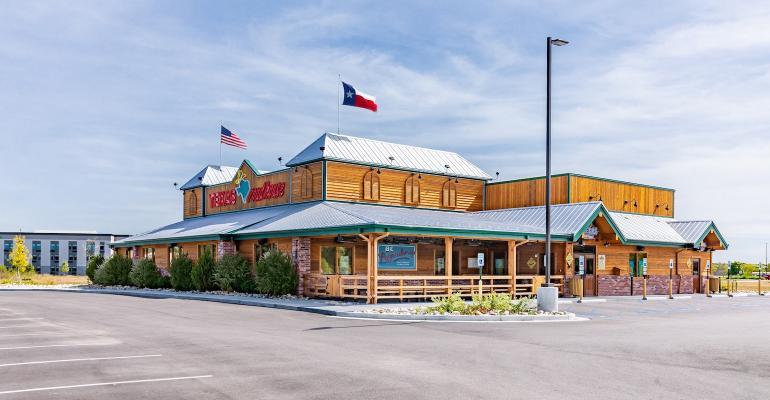Texas Roadhouse reported third quarter earnings Thursday, including an 8.2% increase in comp store sales at company-owned restaurants and a 6.7% increase at domestic franchise restaurants.
Average weekly sales at company restaurants were up nearly $10,000 versus last year – $129,278 versus $120,094 – and off-premises business made up nearly 13% of those sales in Q3. Though the company has taken some pricing, including 2.9% on the quarter, traffic trends remain positive, providing plenty of optimism for executives. In fact, traffic for the company is up by more than 10% over 2019 numbers.
“I think the health of the consumer feels good. Demand continues to be strong for our brands. We’re seeing good traffic growth across all dayparts and days of the week, so from that standpoint, all good from our perspective,” CFO Tonya Robinson said during the earnings call.
Texas Roadhouse has had 10 years of traffic growth, but now it may also be benefitting from drive-thru fatigue. New data from Gravy Analytics finds that the quick-service category experienced less foot traffic in Q3 versus some fast casual and casual dining brands.
That said, beef costs remain a concern for the steak-centric concept, yet Robinson noted there has been some beef deflation in recent quarters and said the company took less pricing than expected during initial budgeting calls earlier this year.
“I think that speaks to the operators being comfortable with how things are looking versus a year ago when we were facing some pretty big uncertainty from the inflation standpoint, particularly on the commodity side and labor,” she said.
Texas Roadhouse’s menu price increases have lagged behind the two-year inflation rate, as well as many of its peers in the industry, which may give the chain a little more leverage if beef prices continue to increase, as some analysts expect.
In the meantime, executives believe the company's momentum could lead to 900 Roadhouses, up from the current 600-plus units. CEO Jerry Morgan is particularly bullish on development because of the success the brand has had in smaller communities.
“We remain encouraged by the performance of our newest restaurants, including Texas Roadhouse openings, in smaller towns. This performance confirms our believe that we still have significant growth opportunities for many years to come,” he said.
To meet that higher volume and development demand, Robinson said the company has “gotten to a point where we feel very comfortable with our staffing.” This is an important factor as labor remains challenged across the industry and as several concepts have trimmed their hours accordingly, leaving money on the table.
“We continue to get fully staffed based on the volumes we’re seeing. I would expect it to start kind of getting a bit more back to normal in 2023 and that would be our expectation,” Robinson said. “We’re always making sure our operators staff for the sales they have, the sales they want and they’re making the right call on that,” Robinson said.
On the heels of this positive quarter, Texas Roadhouse executives are optimistic about Q4, especially given historically strong gift card sales. Executives are also optimistic about 2023, despite growing predictions of a recession.
“As we head into November and gift card sales’ season, we’re trending very, very well and that will continue as we put our big push on gift card sales,” Morgan said. “We’re prepared to keep executing and doing what the consumer wants and I think they’ll reward us for it.”
That said, if consumer pressures continue to mount in 2023, Texas Roadhouse executives believe the company is well positioned. Robinson points to the Great Recession of 2008-09, when the chain outperformed the casual dining segment.
“The value that we have in the menu is really the benefit there and the big thing for us that we focus on is the fact that, following that (recession), we generated 10 years of positive traffic growth,” she said. “So, we know that consistency is what’s so important.”
Morgan added that the key component for the company amid such volatility is its ability to adjust to volumes.
“We didn’t change portion sizes, we didn’t lose focus on the food or service or experience,” he said. “In tough times, you make adjustments, but you still deliver on your promise.”
Contact Alicia at [email protected]
Find her on Twitter: @BGbunster





